Audit Model Case Study Report: Internal Audit Analysis
VerifiedAdded on 2022/10/10
|11
|2992
|382
Report
AI Summary
This report presents a comprehensive case study of an audit model within a central government department responsible for subsidy payments to agricultural businesses. The analysis begins with an evaluation of the internal audit activities within the claims processing unit, identifying inherent, control, and detection risks. The report scrutinizes the department's internal control system, highlighting weaknesses such as the lack of financial accounting systems and inadequate documentation. It then provides recommendations to mitigate the identified risks, including enhanced risk assessment, increased transaction sampling, and thorough verification of claimant details. The second part of the report examines the responsibilities of company directors concerning the maintenance of books and records, emphasizing the auditor's role in verifying the accuracy of financial statements and the directors' accountability for complying with legal requirements. The report underscores the importance of a robust audit process to ensure transparency and reduce financial audit risk.
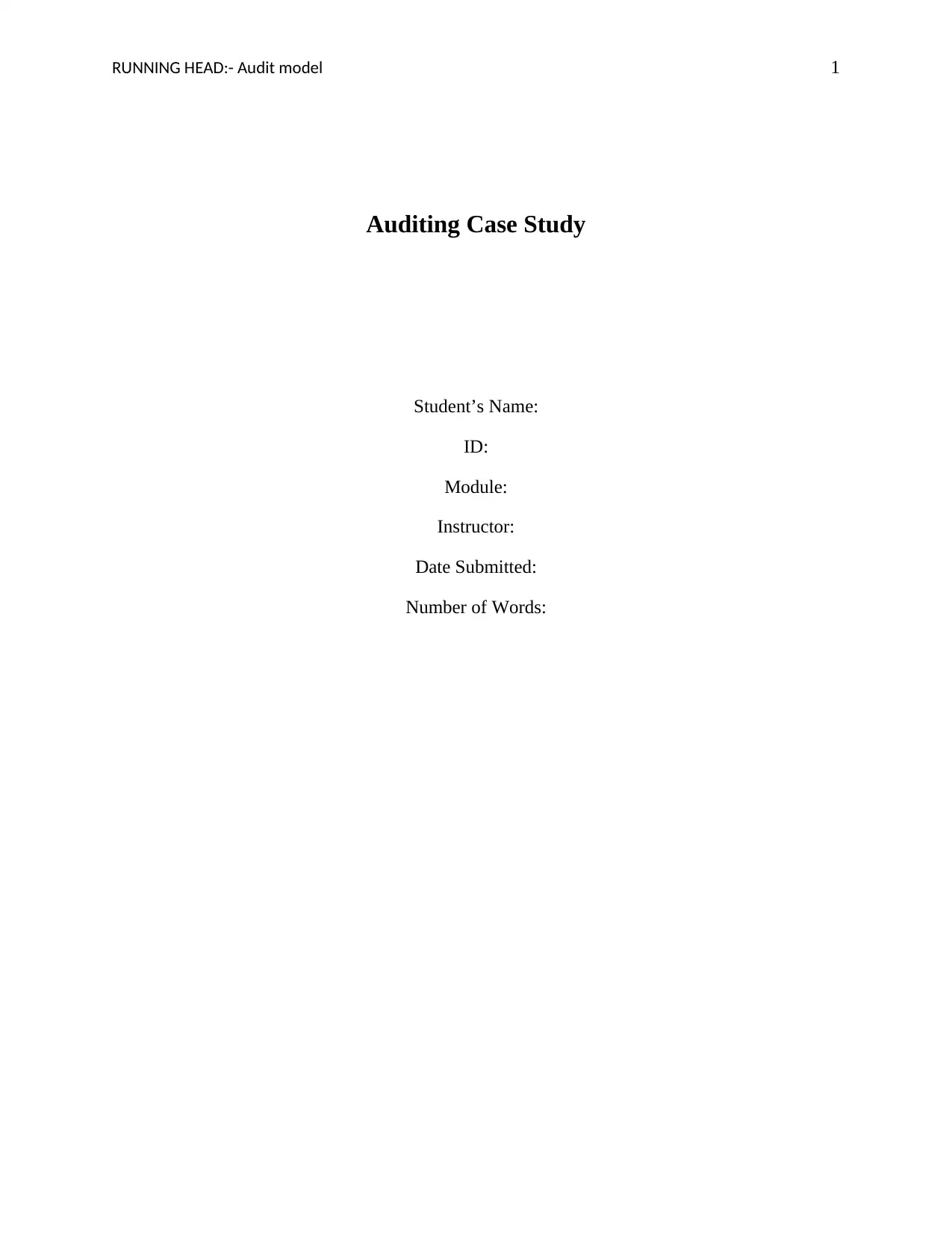
RUNNING HEAD:- Audit model 1
Auditing Case Study
Student’s Name:
ID:
Module:
Instructor:
Date Submitted:
Number of Words:
Auditing Case Study
Student’s Name:
ID:
Module:
Instructor:
Date Submitted:
Number of Words:
Paraphrase This Document
Need a fresh take? Get an instant paraphrase of this document with our AI Paraphraser
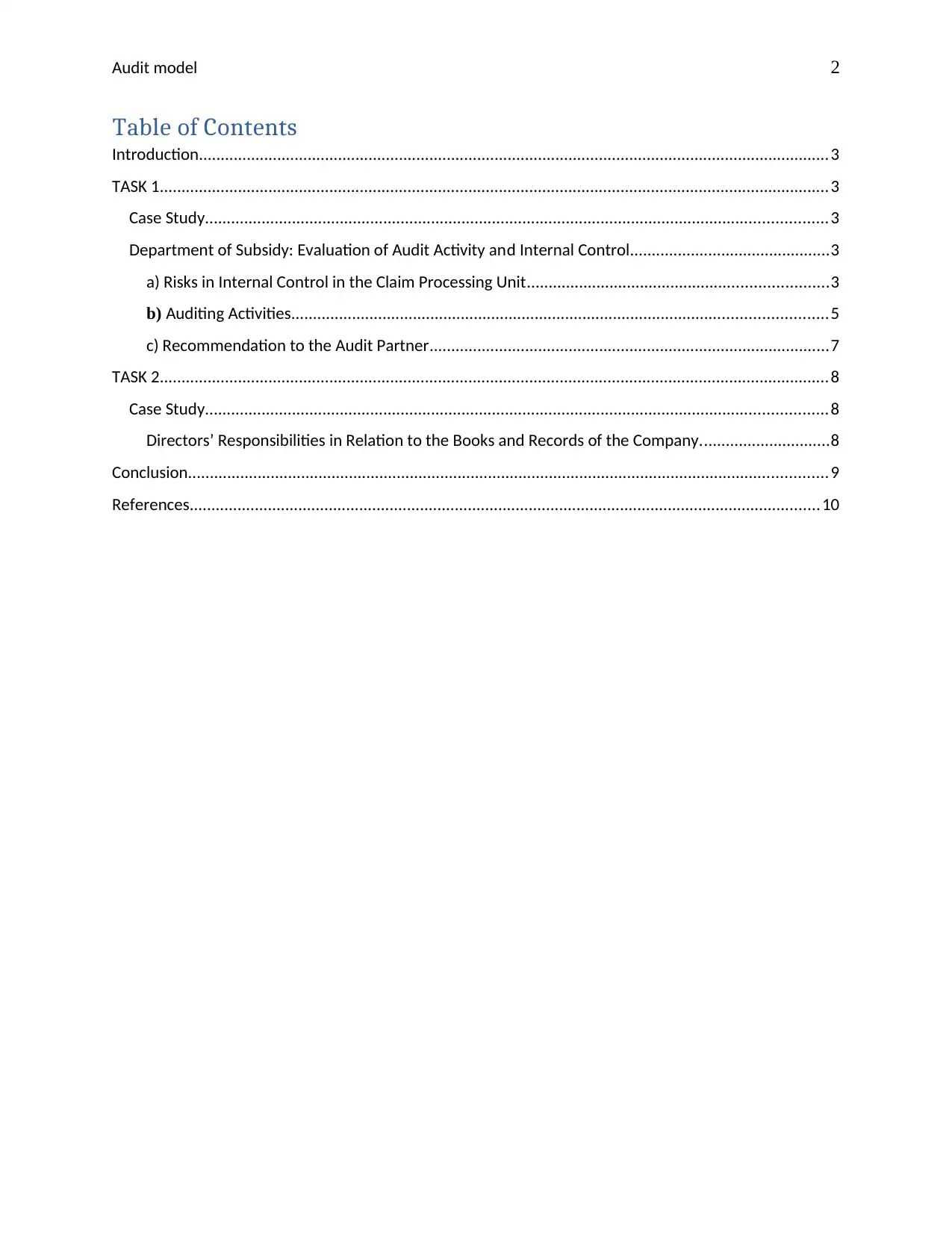
Audit model 2
Table of Contents
Introduction.................................................................................................................................................3
TASK 1..........................................................................................................................................................3
Case Study...............................................................................................................................................3
Department of Subsidy: Evaluation of Audit Activity and Internal Control..............................................3
a) Risks in Internal Control in the Claim Processing Unit.....................................................................3
b) Auditing Activities...........................................................................................................................5
c) Recommendation to the Audit Partner............................................................................................7
TASK 2..........................................................................................................................................................8
Case Study...............................................................................................................................................8
Directors’ Responsibilities in Relation to the Books and Records of the Company..............................8
Conclusion...................................................................................................................................................9
References.................................................................................................................................................10
Table of Contents
Introduction.................................................................................................................................................3
TASK 1..........................................................................................................................................................3
Case Study...............................................................................................................................................3
Department of Subsidy: Evaluation of Audit Activity and Internal Control..............................................3
a) Risks in Internal Control in the Claim Processing Unit.....................................................................3
b) Auditing Activities...........................................................................................................................5
c) Recommendation to the Audit Partner............................................................................................7
TASK 2..........................................................................................................................................................8
Case Study...............................................................................................................................................8
Directors’ Responsibilities in Relation to the Books and Records of the Company..............................8
Conclusion...................................................................................................................................................9
References.................................................................................................................................................10
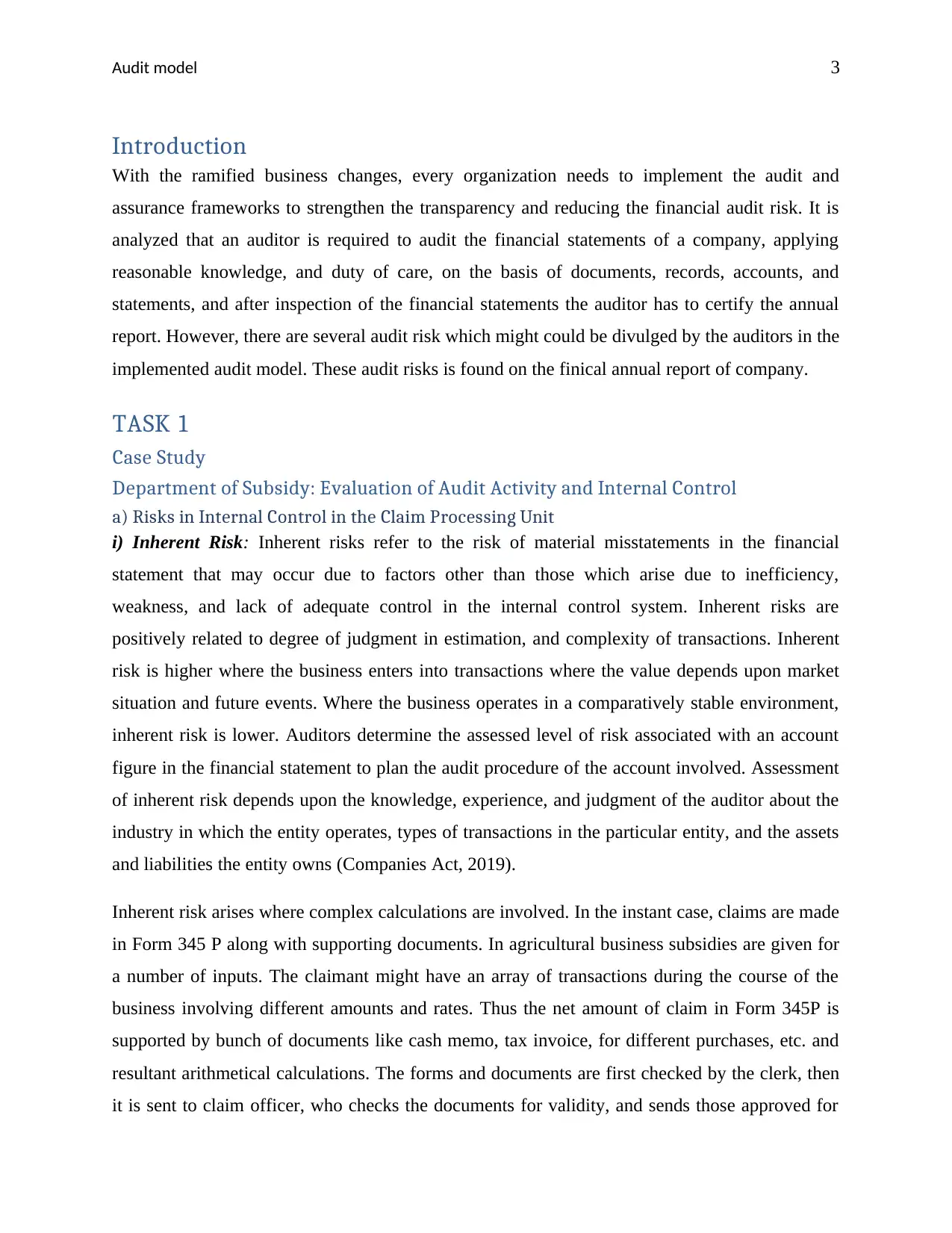
Audit model 3
Introduction
With the ramified business changes, every organization needs to implement the audit and
assurance frameworks to strengthen the transparency and reducing the financial audit risk. It is
analyzed that an auditor is required to audit the financial statements of a company, applying
reasonable knowledge, and duty of care, on the basis of documents, records, accounts, and
statements, and after inspection of the financial statements the auditor has to certify the annual
report. However, there are several audit risk which might could be divulged by the auditors in the
implemented audit model. These audit risks is found on the finical annual report of company.
TASK 1
Case Study
Department of Subsidy: Evaluation of Audit Activity and Internal Control
a) Risks in Internal Control in the Claim Processing Unit
i) Inherent Risk: Inherent risks refer to the risk of material misstatements in the financial
statement that may occur due to factors other than those which arise due to inefficiency,
weakness, and lack of adequate control in the internal control system. Inherent risks are
positively related to degree of judgment in estimation, and complexity of transactions. Inherent
risk is higher where the business enters into transactions where the value depends upon market
situation and future events. Where the business operates in a comparatively stable environment,
inherent risk is lower. Auditors determine the assessed level of risk associated with an account
figure in the financial statement to plan the audit procedure of the account involved. Assessment
of inherent risk depends upon the knowledge, experience, and judgment of the auditor about the
industry in which the entity operates, types of transactions in the particular entity, and the assets
and liabilities the entity owns (Companies Act, 2019).
Inherent risk arises where complex calculations are involved. In the instant case, claims are made
in Form 345 P along with supporting documents. In agricultural business subsidies are given for
a number of inputs. The claimant might have an array of transactions during the course of the
business involving different amounts and rates. Thus the net amount of claim in Form 345P is
supported by bunch of documents like cash memo, tax invoice, for different purchases, etc. and
resultant arithmetical calculations. The forms and documents are first checked by the clerk, then
it is sent to claim officer, who checks the documents for validity, and sends those approved for
Introduction
With the ramified business changes, every organization needs to implement the audit and
assurance frameworks to strengthen the transparency and reducing the financial audit risk. It is
analyzed that an auditor is required to audit the financial statements of a company, applying
reasonable knowledge, and duty of care, on the basis of documents, records, accounts, and
statements, and after inspection of the financial statements the auditor has to certify the annual
report. However, there are several audit risk which might could be divulged by the auditors in the
implemented audit model. These audit risks is found on the finical annual report of company.
TASK 1
Case Study
Department of Subsidy: Evaluation of Audit Activity and Internal Control
a) Risks in Internal Control in the Claim Processing Unit
i) Inherent Risk: Inherent risks refer to the risk of material misstatements in the financial
statement that may occur due to factors other than those which arise due to inefficiency,
weakness, and lack of adequate control in the internal control system. Inherent risks are
positively related to degree of judgment in estimation, and complexity of transactions. Inherent
risk is higher where the business enters into transactions where the value depends upon market
situation and future events. Where the business operates in a comparatively stable environment,
inherent risk is lower. Auditors determine the assessed level of risk associated with an account
figure in the financial statement to plan the audit procedure of the account involved. Assessment
of inherent risk depends upon the knowledge, experience, and judgment of the auditor about the
industry in which the entity operates, types of transactions in the particular entity, and the assets
and liabilities the entity owns (Companies Act, 2019).
Inherent risk arises where complex calculations are involved. In the instant case, claims are made
in Form 345 P along with supporting documents. In agricultural business subsidies are given for
a number of inputs. The claimant might have an array of transactions during the course of the
business involving different amounts and rates. Thus the net amount of claim in Form 345P is
supported by bunch of documents like cash memo, tax invoice, for different purchases, etc. and
resultant arithmetical calculations. The forms and documents are first checked by the clerk, then
it is sent to claim officer, who checks the documents for validity, and sends those approved for
⊘ This is a preview!⊘
Do you want full access?
Subscribe today to unlock all pages.

Trusted by 1+ million students worldwide
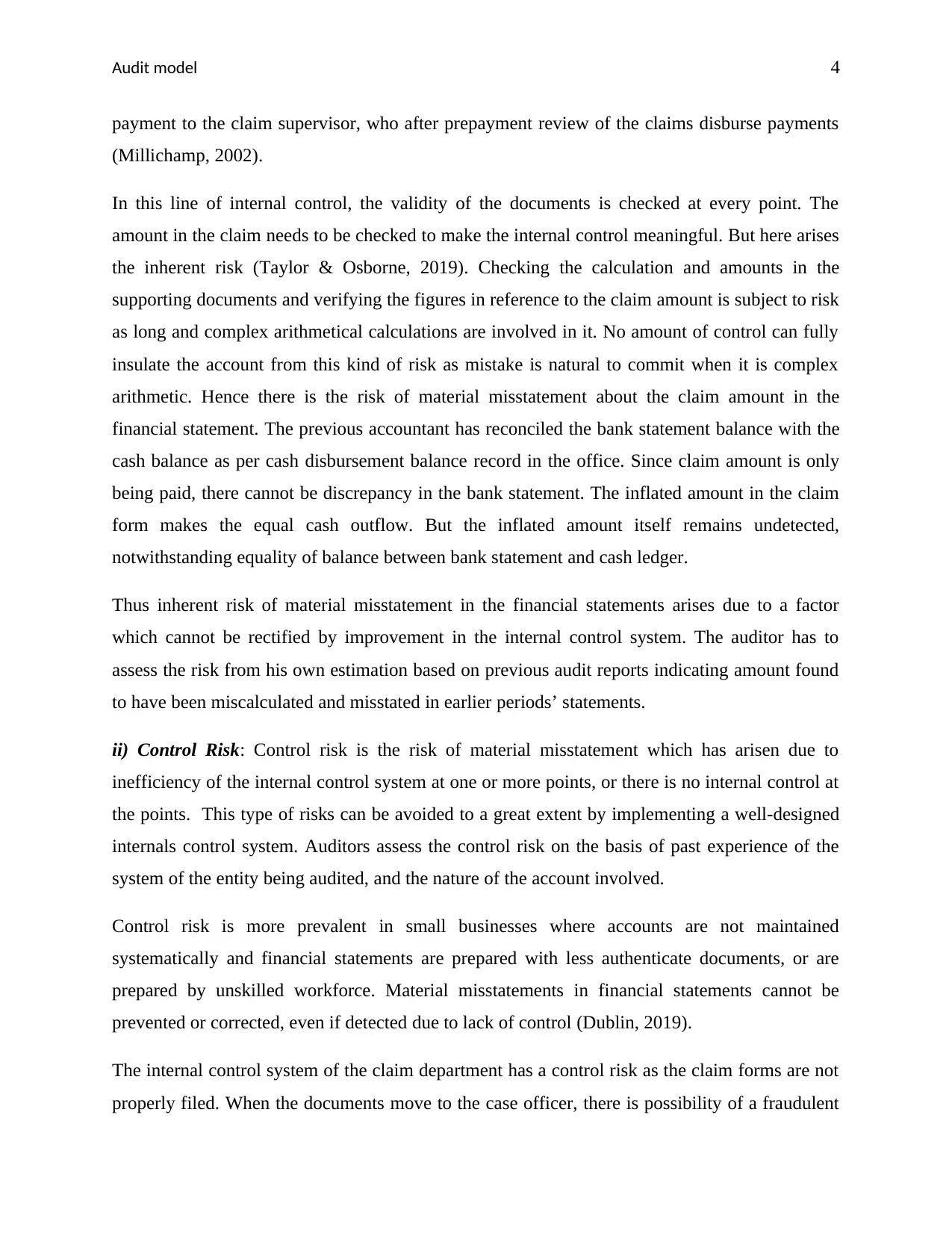
Audit model 4
payment to the claim supervisor, who after prepayment review of the claims disburse payments
(Millichamp, 2002).
In this line of internal control, the validity of the documents is checked at every point. The
amount in the claim needs to be checked to make the internal control meaningful. But here arises
the inherent risk (Taylor & Osborne, 2019). Checking the calculation and amounts in the
supporting documents and verifying the figures in reference to the claim amount is subject to risk
as long and complex arithmetical calculations are involved in it. No amount of control can fully
insulate the account from this kind of risk as mistake is natural to commit when it is complex
arithmetic. Hence there is the risk of material misstatement about the claim amount in the
financial statement. The previous accountant has reconciled the bank statement balance with the
cash balance as per cash disbursement balance record in the office. Since claim amount is only
being paid, there cannot be discrepancy in the bank statement. The inflated amount in the claim
form makes the equal cash outflow. But the inflated amount itself remains undetected,
notwithstanding equality of balance between bank statement and cash ledger.
Thus inherent risk of material misstatement in the financial statements arises due to a factor
which cannot be rectified by improvement in the internal control system. The auditor has to
assess the risk from his own estimation based on previous audit reports indicating amount found
to have been miscalculated and misstated in earlier periods’ statements.
ii) Control Risk: Control risk is the risk of material misstatement which has arisen due to
inefficiency of the internal control system at one or more points, or there is no internal control at
the points. This type of risks can be avoided to a great extent by implementing a well-designed
internals control system. Auditors assess the control risk on the basis of past experience of the
system of the entity being audited, and the nature of the account involved.
Control risk is more prevalent in small businesses where accounts are not maintained
systematically and financial statements are prepared with less authenticate documents, or are
prepared by unskilled workforce. Material misstatements in financial statements cannot be
prevented or corrected, even if detected due to lack of control (Dublin, 2019).
The internal control system of the claim department has a control risk as the claim forms are not
properly filed. When the documents move to the case officer, there is possibility of a fraudulent
payment to the claim supervisor, who after prepayment review of the claims disburse payments
(Millichamp, 2002).
In this line of internal control, the validity of the documents is checked at every point. The
amount in the claim needs to be checked to make the internal control meaningful. But here arises
the inherent risk (Taylor & Osborne, 2019). Checking the calculation and amounts in the
supporting documents and verifying the figures in reference to the claim amount is subject to risk
as long and complex arithmetical calculations are involved in it. No amount of control can fully
insulate the account from this kind of risk as mistake is natural to commit when it is complex
arithmetic. Hence there is the risk of material misstatement about the claim amount in the
financial statement. The previous accountant has reconciled the bank statement balance with the
cash balance as per cash disbursement balance record in the office. Since claim amount is only
being paid, there cannot be discrepancy in the bank statement. The inflated amount in the claim
form makes the equal cash outflow. But the inflated amount itself remains undetected,
notwithstanding equality of balance between bank statement and cash ledger.
Thus inherent risk of material misstatement in the financial statements arises due to a factor
which cannot be rectified by improvement in the internal control system. The auditor has to
assess the risk from his own estimation based on previous audit reports indicating amount found
to have been miscalculated and misstated in earlier periods’ statements.
ii) Control Risk: Control risk is the risk of material misstatement which has arisen due to
inefficiency of the internal control system at one or more points, or there is no internal control at
the points. This type of risks can be avoided to a great extent by implementing a well-designed
internals control system. Auditors assess the control risk on the basis of past experience of the
system of the entity being audited, and the nature of the account involved.
Control risk is more prevalent in small businesses where accounts are not maintained
systematically and financial statements are prepared with less authenticate documents, or are
prepared by unskilled workforce. Material misstatements in financial statements cannot be
prevented or corrected, even if detected due to lack of control (Dublin, 2019).
The internal control system of the claim department has a control risk as the claim forms are not
properly filed. When the documents move to the case officer, there is possibility of a fraudulent
Paraphrase This Document
Need a fresh take? Get an instant paraphrase of this document with our AI Paraphraser
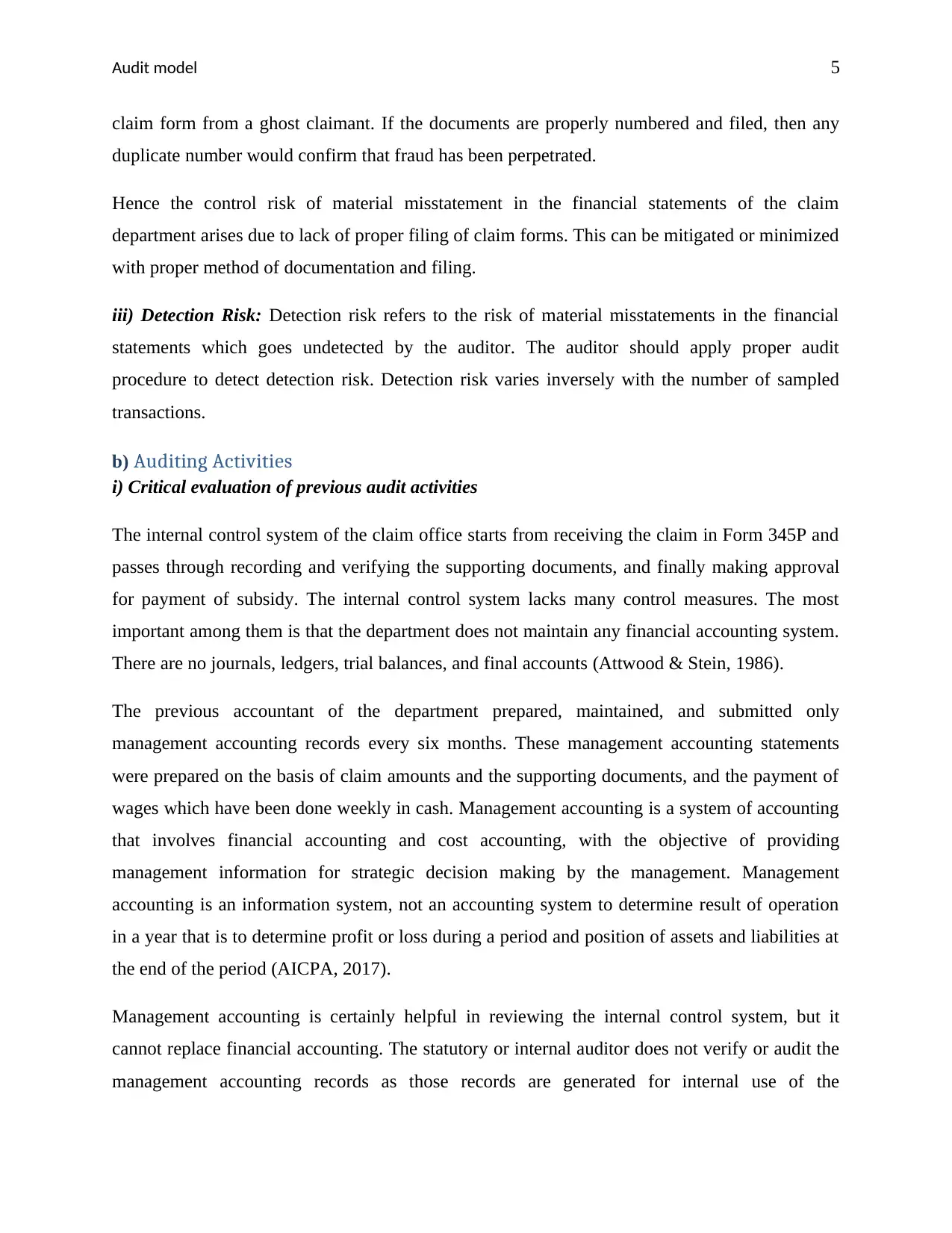
Audit model 5
claim form from a ghost claimant. If the documents are properly numbered and filed, then any
duplicate number would confirm that fraud has been perpetrated.
Hence the control risk of material misstatement in the financial statements of the claim
department arises due to lack of proper filing of claim forms. This can be mitigated or minimized
with proper method of documentation and filing.
iii) Detection Risk: Detection risk refers to the risk of material misstatements in the financial
statements which goes undetected by the auditor. The auditor should apply proper audit
procedure to detect detection risk. Detection risk varies inversely with the number of sampled
transactions.
b) Auditing Activities
i) Critical evaluation of previous audit activities
The internal control system of the claim office starts from receiving the claim in Form 345P and
passes through recording and verifying the supporting documents, and finally making approval
for payment of subsidy. The internal control system lacks many control measures. The most
important among them is that the department does not maintain any financial accounting system.
There are no journals, ledgers, trial balances, and final accounts (Attwood & Stein, 1986).
The previous accountant of the department prepared, maintained, and submitted only
management accounting records every six months. These management accounting statements
were prepared on the basis of claim amounts and the supporting documents, and the payment of
wages which have been done weekly in cash. Management accounting is a system of accounting
that involves financial accounting and cost accounting, with the objective of providing
management information for strategic decision making by the management. Management
accounting is an information system, not an accounting system to determine result of operation
in a year that is to determine profit or loss during a period and position of assets and liabilities at
the end of the period (AICPA, 2017).
Management accounting is certainly helpful in reviewing the internal control system, but it
cannot replace financial accounting. The statutory or internal auditor does not verify or audit the
management accounting records as those records are generated for internal use of the
claim form from a ghost claimant. If the documents are properly numbered and filed, then any
duplicate number would confirm that fraud has been perpetrated.
Hence the control risk of material misstatement in the financial statements of the claim
department arises due to lack of proper filing of claim forms. This can be mitigated or minimized
with proper method of documentation and filing.
iii) Detection Risk: Detection risk refers to the risk of material misstatements in the financial
statements which goes undetected by the auditor. The auditor should apply proper audit
procedure to detect detection risk. Detection risk varies inversely with the number of sampled
transactions.
b) Auditing Activities
i) Critical evaluation of previous audit activities
The internal control system of the claim office starts from receiving the claim in Form 345P and
passes through recording and verifying the supporting documents, and finally making approval
for payment of subsidy. The internal control system lacks many control measures. The most
important among them is that the department does not maintain any financial accounting system.
There are no journals, ledgers, trial balances, and final accounts (Attwood & Stein, 1986).
The previous accountant of the department prepared, maintained, and submitted only
management accounting records every six months. These management accounting statements
were prepared on the basis of claim amounts and the supporting documents, and the payment of
wages which have been done weekly in cash. Management accounting is a system of accounting
that involves financial accounting and cost accounting, with the objective of providing
management information for strategic decision making by the management. Management
accounting is an information system, not an accounting system to determine result of operation
in a year that is to determine profit or loss during a period and position of assets and liabilities at
the end of the period (AICPA, 2017).
Management accounting is certainly helpful in reviewing the internal control system, but it
cannot replace financial accounting. The statutory or internal auditor does not verify or audit the
management accounting records as those records are generated for internal use of the
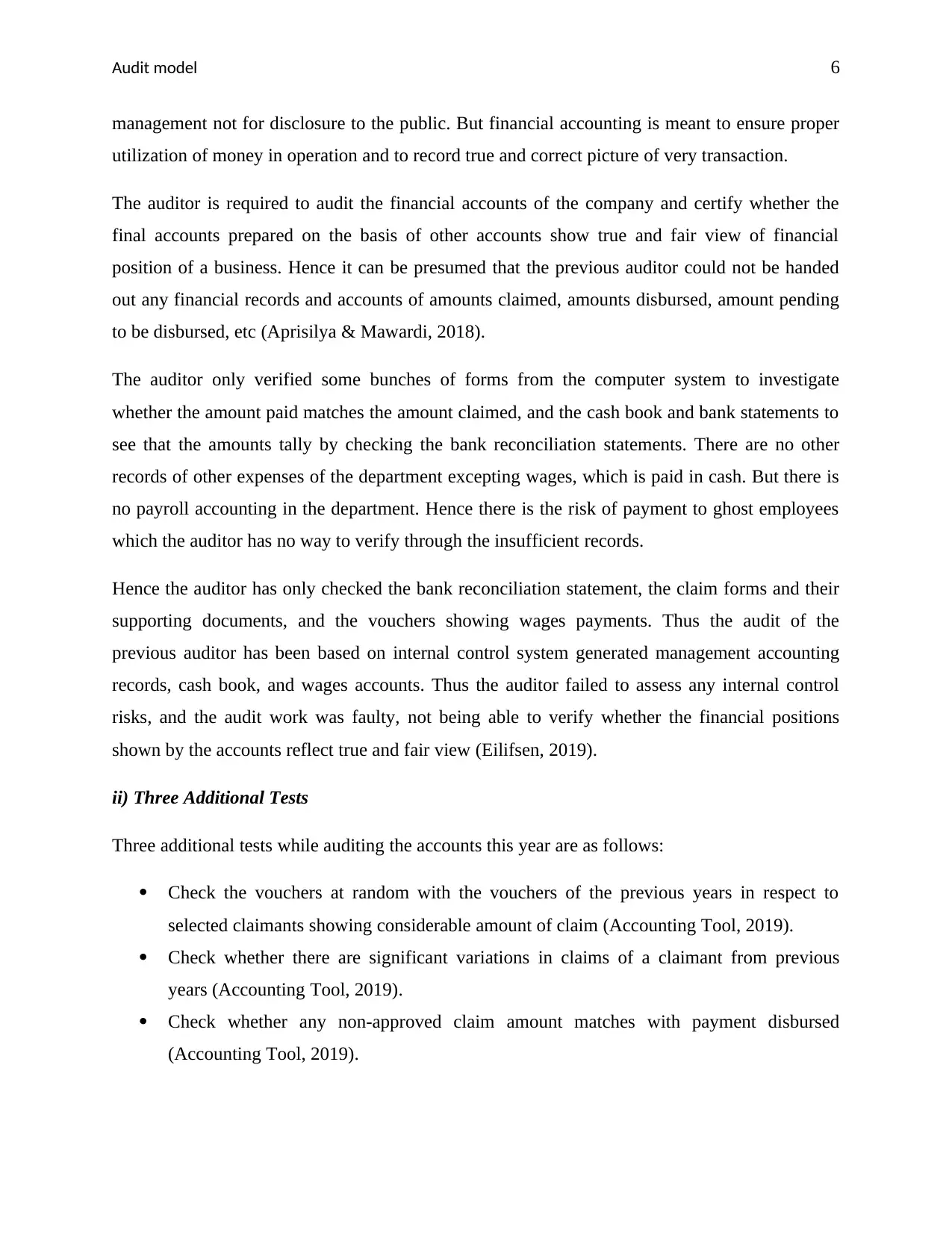
Audit model 6
management not for disclosure to the public. But financial accounting is meant to ensure proper
utilization of money in operation and to record true and correct picture of very transaction.
The auditor is required to audit the financial accounts of the company and certify whether the
final accounts prepared on the basis of other accounts show true and fair view of financial
position of a business. Hence it can be presumed that the previous auditor could not be handed
out any financial records and accounts of amounts claimed, amounts disbursed, amount pending
to be disbursed, etc (Aprisilya & Mawardi, 2018).
The auditor only verified some bunches of forms from the computer system to investigate
whether the amount paid matches the amount claimed, and the cash book and bank statements to
see that the amounts tally by checking the bank reconciliation statements. There are no other
records of other expenses of the department excepting wages, which is paid in cash. But there is
no payroll accounting in the department. Hence there is the risk of payment to ghost employees
which the auditor has no way to verify through the insufficient records.
Hence the auditor has only checked the bank reconciliation statement, the claim forms and their
supporting documents, and the vouchers showing wages payments. Thus the audit of the
previous auditor has been based on internal control system generated management accounting
records, cash book, and wages accounts. Thus the auditor failed to assess any internal control
risks, and the audit work was faulty, not being able to verify whether the financial positions
shown by the accounts reflect true and fair view (Eilifsen, 2019).
ii) Three Additional Tests
Three additional tests while auditing the accounts this year are as follows:
Check the vouchers at random with the vouchers of the previous years in respect to
selected claimants showing considerable amount of claim (Accounting Tool, 2019).
Check whether there are significant variations in claims of a claimant from previous
years (Accounting Tool, 2019).
Check whether any non-approved claim amount matches with payment disbursed
(Accounting Tool, 2019).
management not for disclosure to the public. But financial accounting is meant to ensure proper
utilization of money in operation and to record true and correct picture of very transaction.
The auditor is required to audit the financial accounts of the company and certify whether the
final accounts prepared on the basis of other accounts show true and fair view of financial
position of a business. Hence it can be presumed that the previous auditor could not be handed
out any financial records and accounts of amounts claimed, amounts disbursed, amount pending
to be disbursed, etc (Aprisilya & Mawardi, 2018).
The auditor only verified some bunches of forms from the computer system to investigate
whether the amount paid matches the amount claimed, and the cash book and bank statements to
see that the amounts tally by checking the bank reconciliation statements. There are no other
records of other expenses of the department excepting wages, which is paid in cash. But there is
no payroll accounting in the department. Hence there is the risk of payment to ghost employees
which the auditor has no way to verify through the insufficient records.
Hence the auditor has only checked the bank reconciliation statement, the claim forms and their
supporting documents, and the vouchers showing wages payments. Thus the audit of the
previous auditor has been based on internal control system generated management accounting
records, cash book, and wages accounts. Thus the auditor failed to assess any internal control
risks, and the audit work was faulty, not being able to verify whether the financial positions
shown by the accounts reflect true and fair view (Eilifsen, 2019).
ii) Three Additional Tests
Three additional tests while auditing the accounts this year are as follows:
Check the vouchers at random with the vouchers of the previous years in respect to
selected claimants showing considerable amount of claim (Accounting Tool, 2019).
Check whether there are significant variations in claims of a claimant from previous
years (Accounting Tool, 2019).
Check whether any non-approved claim amount matches with payment disbursed
(Accounting Tool, 2019).
⊘ This is a preview!⊘
Do you want full access?
Subscribe today to unlock all pages.

Trusted by 1+ million students worldwide
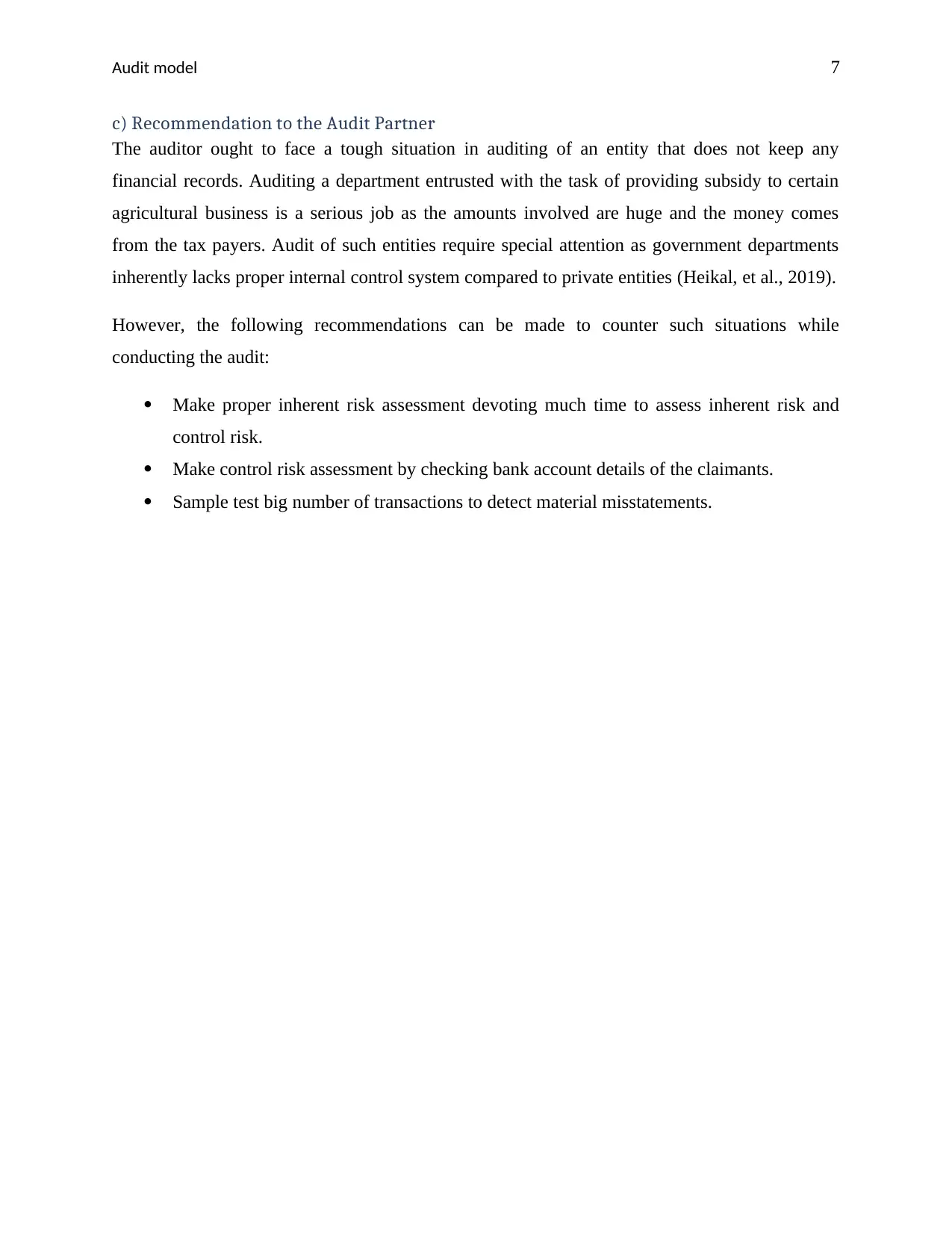
Audit model 7
c) Recommendation to the Audit Partner
The auditor ought to face a tough situation in auditing of an entity that does not keep any
financial records. Auditing a department entrusted with the task of providing subsidy to certain
agricultural business is a serious job as the amounts involved are huge and the money comes
from the tax payers. Audit of such entities require special attention as government departments
inherently lacks proper internal control system compared to private entities (Heikal, et al., 2019).
However, the following recommendations can be made to counter such situations while
conducting the audit:
Make proper inherent risk assessment devoting much time to assess inherent risk and
control risk.
Make control risk assessment by checking bank account details of the claimants.
Sample test big number of transactions to detect material misstatements.
c) Recommendation to the Audit Partner
The auditor ought to face a tough situation in auditing of an entity that does not keep any
financial records. Auditing a department entrusted with the task of providing subsidy to certain
agricultural business is a serious job as the amounts involved are huge and the money comes
from the tax payers. Audit of such entities require special attention as government departments
inherently lacks proper internal control system compared to private entities (Heikal, et al., 2019).
However, the following recommendations can be made to counter such situations while
conducting the audit:
Make proper inherent risk assessment devoting much time to assess inherent risk and
control risk.
Make control risk assessment by checking bank account details of the claimants.
Sample test big number of transactions to detect material misstatements.
Paraphrase This Document
Need a fresh take? Get an instant paraphrase of this document with our AI Paraphraser
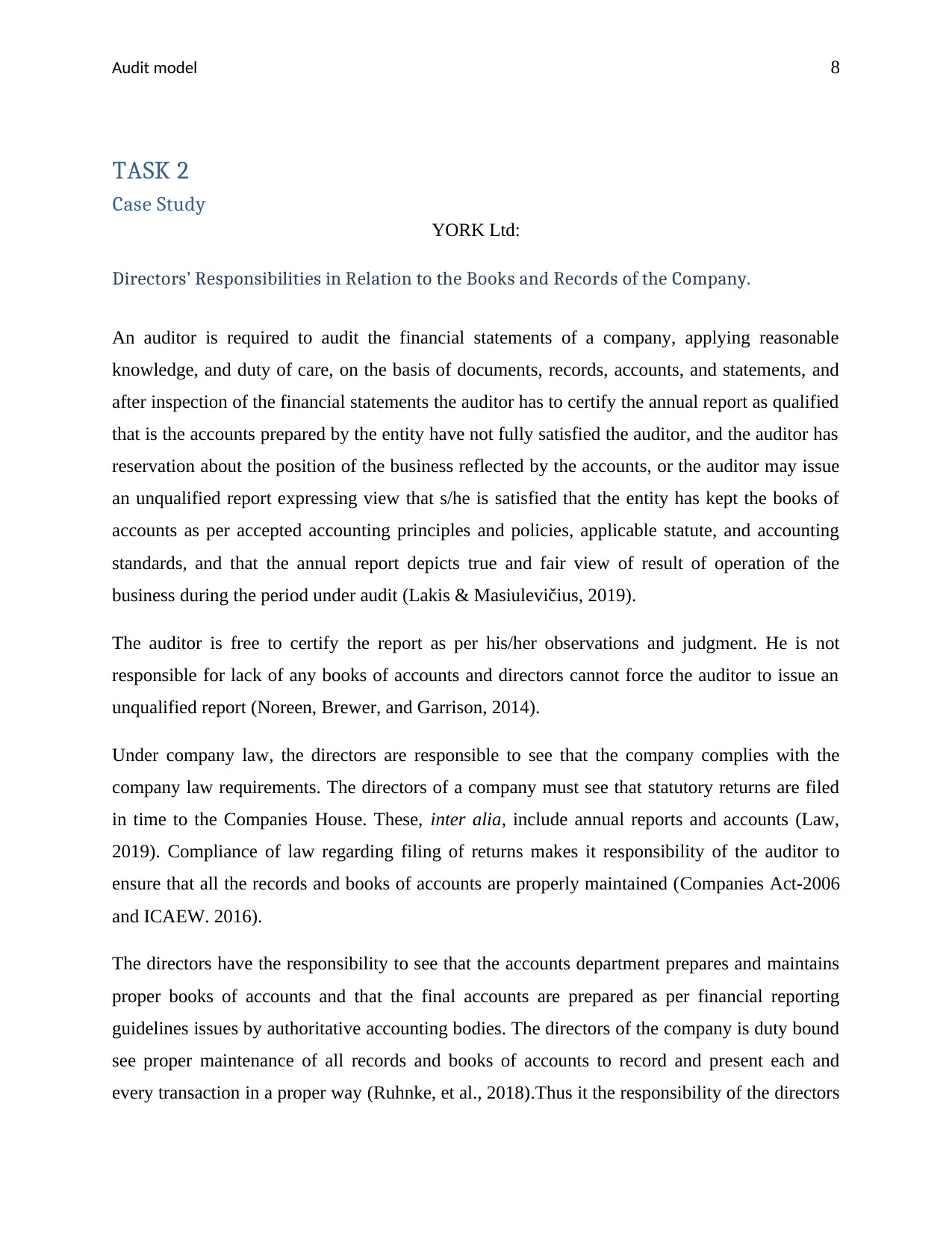
Audit model 8
TASK 2
Case Study
YORK Ltd:
Directors’ Responsibilities in Relation to the Books and Records of the Company.
An auditor is required to audit the financial statements of a company, applying reasonable
knowledge, and duty of care, on the basis of documents, records, accounts, and statements, and
after inspection of the financial statements the auditor has to certify the annual report as qualified
that is the accounts prepared by the entity have not fully satisfied the auditor, and the auditor has
reservation about the position of the business reflected by the accounts, or the auditor may issue
an unqualified report expressing view that s/he is satisfied that the entity has kept the books of
accounts as per accepted accounting principles and policies, applicable statute, and accounting
standards, and that the annual report depicts true and fair view of result of operation of the
business during the period under audit (Lakis & Masiulevičius, 2019).
The auditor is free to certify the report as per his/her observations and judgment. He is not
responsible for lack of any books of accounts and directors cannot force the auditor to issue an
unqualified report (Noreen, Brewer, and Garrison, 2014).
Under company law, the directors are responsible to see that the company complies with the
company law requirements. The directors of a company must see that statutory returns are filed
in time to the Companies House. These, inter alia, include annual reports and accounts (Law,
2019). Compliance of law regarding filing of returns makes it responsibility of the auditor to
ensure that all the records and books of accounts are properly maintained (Companies Act-2006
and ICAEW. 2016).
The directors have the responsibility to see that the accounts department prepares and maintains
proper books of accounts and that the final accounts are prepared as per financial reporting
guidelines issues by authoritative accounting bodies. The directors of the company is duty bound
see proper maintenance of all records and books of accounts to record and present each and
every transaction in a proper way (Ruhnke, et al., 2018).Thus it the responsibility of the directors
TASK 2
Case Study
YORK Ltd:
Directors’ Responsibilities in Relation to the Books and Records of the Company.
An auditor is required to audit the financial statements of a company, applying reasonable
knowledge, and duty of care, on the basis of documents, records, accounts, and statements, and
after inspection of the financial statements the auditor has to certify the annual report as qualified
that is the accounts prepared by the entity have not fully satisfied the auditor, and the auditor has
reservation about the position of the business reflected by the accounts, or the auditor may issue
an unqualified report expressing view that s/he is satisfied that the entity has kept the books of
accounts as per accepted accounting principles and policies, applicable statute, and accounting
standards, and that the annual report depicts true and fair view of result of operation of the
business during the period under audit (Lakis & Masiulevičius, 2019).
The auditor is free to certify the report as per his/her observations and judgment. He is not
responsible for lack of any books of accounts and directors cannot force the auditor to issue an
unqualified report (Noreen, Brewer, and Garrison, 2014).
Under company law, the directors are responsible to see that the company complies with the
company law requirements. The directors of a company must see that statutory returns are filed
in time to the Companies House. These, inter alia, include annual reports and accounts (Law,
2019). Compliance of law regarding filing of returns makes it responsibility of the auditor to
ensure that all the records and books of accounts are properly maintained (Companies Act-2006
and ICAEW. 2016).
The directors have the responsibility to see that the accounts department prepares and maintains
proper books of accounts and that the final accounts are prepared as per financial reporting
guidelines issues by authoritative accounting bodies. The directors of the company is duty bound
see proper maintenance of all records and books of accounts to record and present each and
every transaction in a proper way (Ruhnke, et al., 2018).Thus it the responsibility of the directors
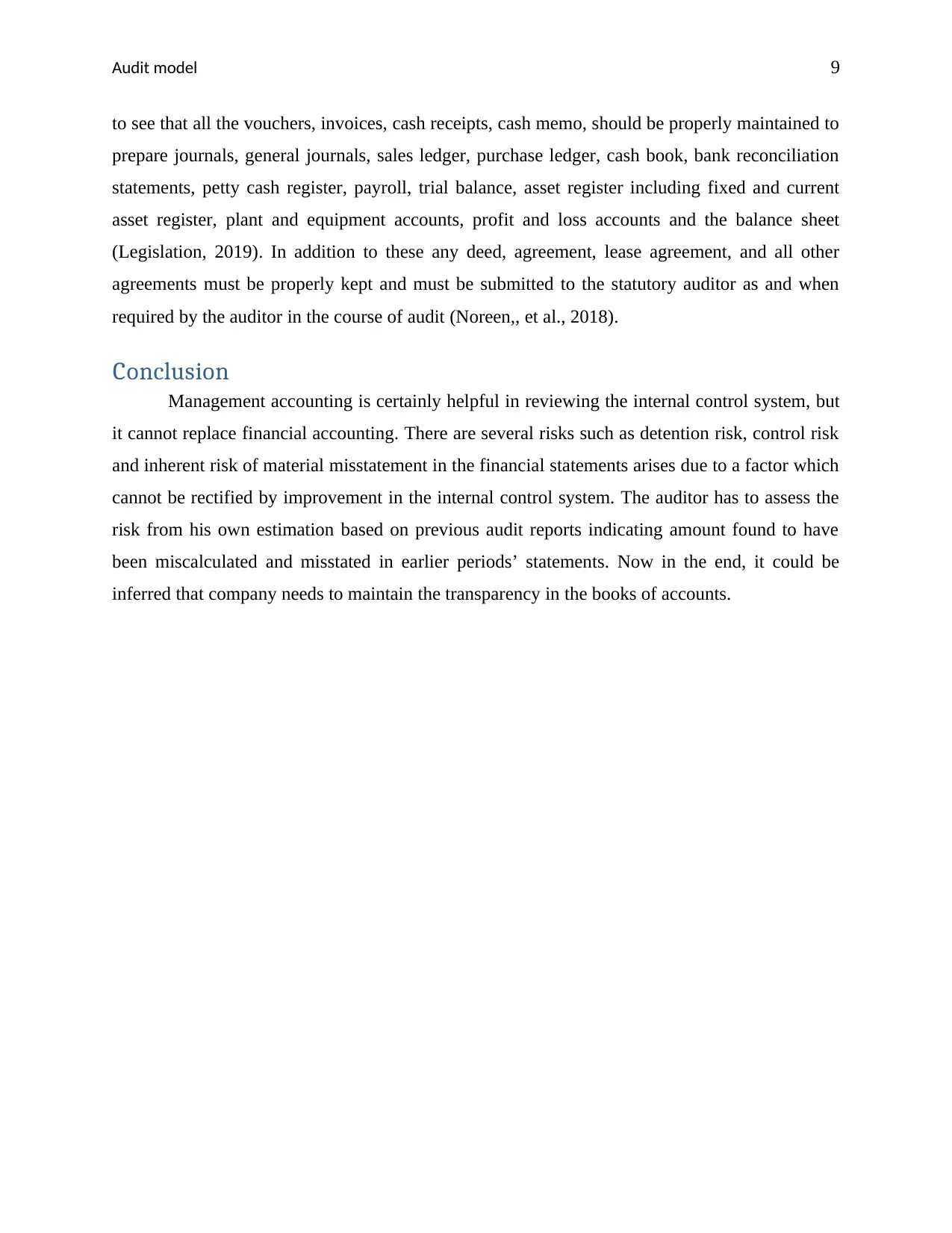
Audit model 9
to see that all the vouchers, invoices, cash receipts, cash memo, should be properly maintained to
prepare journals, general journals, sales ledger, purchase ledger, cash book, bank reconciliation
statements, petty cash register, payroll, trial balance, asset register including fixed and current
asset register, plant and equipment accounts, profit and loss accounts and the balance sheet
(Legislation, 2019). In addition to these any deed, agreement, lease agreement, and all other
agreements must be properly kept and must be submitted to the statutory auditor as and when
required by the auditor in the course of audit (Noreen,, et al., 2018).
Conclusion
Management accounting is certainly helpful in reviewing the internal control system, but
it cannot replace financial accounting. There are several risks such as detention risk, control risk
and inherent risk of material misstatement in the financial statements arises due to a factor which
cannot be rectified by improvement in the internal control system. The auditor has to assess the
risk from his own estimation based on previous audit reports indicating amount found to have
been miscalculated and misstated in earlier periods’ statements. Now in the end, it could be
inferred that company needs to maintain the transparency in the books of accounts.
to see that all the vouchers, invoices, cash receipts, cash memo, should be properly maintained to
prepare journals, general journals, sales ledger, purchase ledger, cash book, bank reconciliation
statements, petty cash register, payroll, trial balance, asset register including fixed and current
asset register, plant and equipment accounts, profit and loss accounts and the balance sheet
(Legislation, 2019). In addition to these any deed, agreement, lease agreement, and all other
agreements must be properly kept and must be submitted to the statutory auditor as and when
required by the auditor in the course of audit (Noreen,, et al., 2018).
Conclusion
Management accounting is certainly helpful in reviewing the internal control system, but
it cannot replace financial accounting. There are several risks such as detention risk, control risk
and inherent risk of material misstatement in the financial statements arises due to a factor which
cannot be rectified by improvement in the internal control system. The auditor has to assess the
risk from his own estimation based on previous audit reports indicating amount found to have
been miscalculated and misstated in earlier periods’ statements. Now in the end, it could be
inferred that company needs to maintain the transparency in the books of accounts.
⊘ This is a preview!⊘
Do you want full access?
Subscribe today to unlock all pages.

Trusted by 1+ million students worldwide
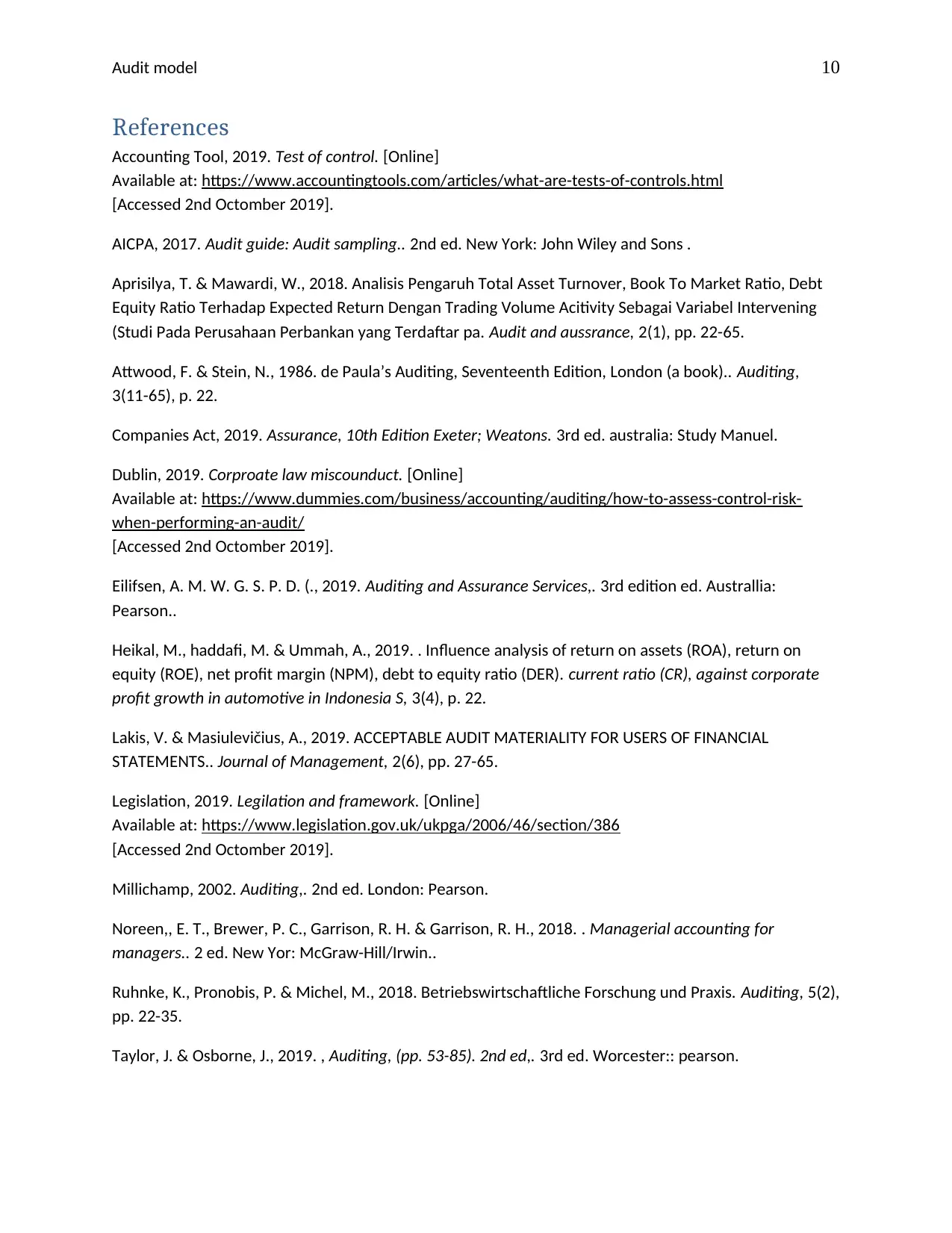
Audit model 10
References
Accounting Tool, 2019. Test of control. [Online]
Available at: https://www.accountingtools.com/articles/what-are-tests-of-controls.html
[Accessed 2nd Octomber 2019].
AICPA, 2017. Audit guide: Audit sampling.. 2nd ed. New York: John Wiley and Sons .
Aprisilya, T. & Mawardi, W., 2018. Analisis Pengaruh Total Asset Turnover, Book To Market Ratio, Debt
Equity Ratio Terhadap Expected Return Dengan Trading Volume Acitivity Sebagai Variabel Intervening
(Studi Pada Perusahaan Perbankan yang Terdaftar pa. Audit and aussrance, 2(1), pp. 22-65.
Attwood, F. & Stein, N., 1986. de Paula’s Auditing, Seventeenth Edition, London (a book).. Auditing,
3(11-65), p. 22.
Companies Act, 2019. Assurance, 10th Edition Exeter; Weatons. 3rd ed. australia: Study Manuel.
Dublin, 2019. Corproate law miscounduct. [Online]
Available at: https://www.dummies.com/business/accounting/auditing/how-to-assess-control-risk-
when-performing-an-audit/
[Accessed 2nd Octomber 2019].
Eilifsen, A. M. W. G. S. P. D. (., 2019. Auditing and Assurance Services,. 3rd edition ed. Australlia:
Pearson..
Heikal, M., haddafi, M. & Ummah, A., 2019. . Influence analysis of return on assets (ROA), return on
equity (ROE), net profit margin (NPM), debt to equity ratio (DER). current ratio (CR), against corporate
profit growth in automotive in Indonesia S, 3(4), p. 22.
Lakis, V. & Masiulevičius, A., 2019. ACCEPTABLE AUDIT MATERIALITY FOR USERS OF FINANCIAL
STATEMENTS.. Journal of Management, 2(6), pp. 27-65.
Legislation, 2019. Legilation and framework. [Online]
Available at: https://www.legislation.gov.uk/ukpga/2006/46/section/386
[Accessed 2nd Octomber 2019].
Millichamp, 2002. Auditing,. 2nd ed. London: Pearson.
Noreen,, E. T., Brewer, P. C., Garrison, R. H. & Garrison, R. H., 2018. . Managerial accounting for
managers.. 2 ed. New Yor: McGraw-Hill/Irwin..
Ruhnke, K., Pronobis, P. & Michel, M., 2018. Betriebswirtschaftliche Forschung und Praxis. Auditing, 5(2),
pp. 22-35.
Taylor, J. & Osborne, J., 2019. , Auditing, (pp. 53-85). 2nd ed,. 3rd ed. Worcester:: pearson.
References
Accounting Tool, 2019. Test of control. [Online]
Available at: https://www.accountingtools.com/articles/what-are-tests-of-controls.html
[Accessed 2nd Octomber 2019].
AICPA, 2017. Audit guide: Audit sampling.. 2nd ed. New York: John Wiley and Sons .
Aprisilya, T. & Mawardi, W., 2018. Analisis Pengaruh Total Asset Turnover, Book To Market Ratio, Debt
Equity Ratio Terhadap Expected Return Dengan Trading Volume Acitivity Sebagai Variabel Intervening
(Studi Pada Perusahaan Perbankan yang Terdaftar pa. Audit and aussrance, 2(1), pp. 22-65.
Attwood, F. & Stein, N., 1986. de Paula’s Auditing, Seventeenth Edition, London (a book).. Auditing,
3(11-65), p. 22.
Companies Act, 2019. Assurance, 10th Edition Exeter; Weatons. 3rd ed. australia: Study Manuel.
Dublin, 2019. Corproate law miscounduct. [Online]
Available at: https://www.dummies.com/business/accounting/auditing/how-to-assess-control-risk-
when-performing-an-audit/
[Accessed 2nd Octomber 2019].
Eilifsen, A. M. W. G. S. P. D. (., 2019. Auditing and Assurance Services,. 3rd edition ed. Australlia:
Pearson..
Heikal, M., haddafi, M. & Ummah, A., 2019. . Influence analysis of return on assets (ROA), return on
equity (ROE), net profit margin (NPM), debt to equity ratio (DER). current ratio (CR), against corporate
profit growth in automotive in Indonesia S, 3(4), p. 22.
Lakis, V. & Masiulevičius, A., 2019. ACCEPTABLE AUDIT MATERIALITY FOR USERS OF FINANCIAL
STATEMENTS.. Journal of Management, 2(6), pp. 27-65.
Legislation, 2019. Legilation and framework. [Online]
Available at: https://www.legislation.gov.uk/ukpga/2006/46/section/386
[Accessed 2nd Octomber 2019].
Millichamp, 2002. Auditing,. 2nd ed. London: Pearson.
Noreen,, E. T., Brewer, P. C., Garrison, R. H. & Garrison, R. H., 2018. . Managerial accounting for
managers.. 2 ed. New Yor: McGraw-Hill/Irwin..
Ruhnke, K., Pronobis, P. & Michel, M., 2018. Betriebswirtschaftliche Forschung und Praxis. Auditing, 5(2),
pp. 22-35.
Taylor, J. & Osborne, J., 2019. , Auditing, (pp. 53-85). 2nd ed,. 3rd ed. Worcester:: pearson.
Paraphrase This Document
Need a fresh take? Get an instant paraphrase of this document with our AI Paraphraser

Audit model 11
1 out of 11
Related Documents
Your All-in-One AI-Powered Toolkit for Academic Success.
+13062052269
info@desklib.com
Available 24*7 on WhatsApp / Email
![[object Object]](/_next/static/media/star-bottom.7253800d.svg)
Unlock your academic potential
Copyright © 2020–2025 A2Z Services. All Rights Reserved. Developed and managed by ZUCOL.





